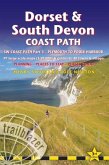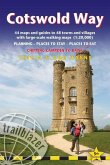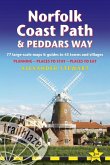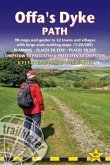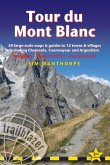Stuart Greig, Bradley Mayhew
Pennine Way
Edale to Kirk Yetholm - Planning, places to stay and places to eat
Stuart Greig, Bradley Mayhew
Pennine Way
Edale to Kirk Yetholm - Planning, places to stay and places to eat
- Broschiertes Buch
- Merkliste
- Auf die Merkliste
- Bewerten Bewerten
- Teilen
- Produkt teilen
- Produkterinnerung
- Produkterinnerung
Trailblazer British Walking Guide to the Pennine Way, Britain's best-known National Trail that winds for 256 miles through three National Parks - the Peak District, Yorkshire Dales and Northumberland.
Andere Kunden interessierten sich auch für
![Dorset & South Devon Coast Path Dorset & South Devon Coast Path]() Henry StedmanDorset & South Devon Coast Path17,99 €
Henry StedmanDorset & South Devon Coast Path17,99 €![South Downs Way South Downs Way]() Jim ManthorpeSouth Downs Way16,99 €
Jim ManthorpeSouth Downs Way16,99 €![Cotswold Way Cotswold Way]() Cotswold Way21,99 €
Cotswold Way21,99 €![Norfolk Coast Path & Peddars Norfolk Coast Path & Peddars]() Alexander StewartNorfolk Coast Path & Peddars17,99 €
Alexander StewartNorfolk Coast Path & Peddars17,99 €![Offa's Dyke Path Offa's Dyke Path]() Keith CarterOffa's Dyke Path17,99 €
Keith CarterOffa's Dyke Path17,99 €![The Ridgeway The Ridgeway]() Nick HillThe Ridgeway17,99 €
Nick HillThe Ridgeway17,99 €![Tour du Mont Blanc Tour du Mont Blanc]() Jim ManthorpeTour du Mont Blanc18,99 €
Jim ManthorpeTour du Mont Blanc18,99 €-
-
-
Trailblazer British Walking Guide to the Pennine Way, Britain's best-known National Trail that winds for 256 miles through three National Parks - the Peak District, Yorkshire Dales and Northumberland.
Produktdetails
- Produktdetails
- Trailblazer Guides
- Verlag: Trailblazer Publications
- Artikelnr. des Verlages: 37238
- 6 New edition
- Seitenzahl: 320
- Erscheinungstermin: 1. August 2023
- Englisch
- Abmessung: 180mm x 121mm x 22mm
- Gewicht: 298g
- ISBN-13: 9781912716333
- ISBN-10: 191271633X
- Artikelnr.: 66223934
- Herstellerkennzeichnung
- GeoCenter Touristik
- Kurze Straße 40
- 70794 Filderstadt
- vertrieb@geocenter.de
- Trailblazer Guides
- Verlag: Trailblazer Publications
- Artikelnr. des Verlages: 37238
- 6 New edition
- Seitenzahl: 320
- Erscheinungstermin: 1. August 2023
- Englisch
- Abmessung: 180mm x 121mm x 22mm
- Gewicht: 298g
- ISBN-13: 9781912716333
- ISBN-10: 191271633X
- Artikelnr.: 66223934
- Herstellerkennzeichnung
- GeoCenter Touristik
- Kurze Straße 40
- 70794 Filderstadt
- vertrieb@geocenter.de
Bradley Mayhew is a British travel writer specializing in the mountains of Asia. He is the co-author of Lonely Planet guides to Tibet, Bhutan, Nepal, Trekking in the Nepal Himalaya, Central Asia, India and many others. He is also the co-author of Wilderness Press' Top Trails: Yellowstone & Grand Teton National Parks and starred in a ten-part documentary for European channel Arte on Europe's Most Beautiful Long Distance Trails. Stuart Greig lives near the start of the Pennine Way. He has completed many of the UK's National Trails and undertaken many other multi-day walks in England, Scotland and Wales. In the gaps between long walks, he may be found walking and backpacking shorter routes in the hills of Cumbria and Yorkshire. The authors are based in the UK and Chile.
INTRODUCTION
PART 1: PLANNING YOUR WALK 1.1 About the Pennine Way, History
How difficult is the Pennine Way? (route finding)
How long do you need? 1.2Practical information for the walker Accommodation (camping, bunkhouses and hostels, bed and breakfast)
Food and drink (drinking water, buying camping supplies, pubs) (Aside: Beer)
Money
Other services
Walking companies (accommodation booking, baggage carriers, self
guided holidays, group/guided walking tours) 1.3Budgeting Camping
Bunkhouses and hostels
B&Bs
Extras (Aside: Information for foreign visitors) 1.4When to go Seasons (spring, summer, autumn, winter)
Temperature
Rainfall
Daylight hours 1.5 Itineraries and Planning map
Which direction?
Village and town facilities
Suggested itineraries (Asides: Highlights of the Pennine Way
the best day and weekend walks; Walking with dogs)1.6 What to take Keep it light
How to carry it
Footwear (boots, socks, extra footwear)
Clothes (Aside: Cheaper alternatives)
Toiletries
First aid kit (Aside
Mountain rescue)
General items
Sleeping bag
Camping gear
Travel insurance
Maps
Recommended reading (general guidebooks, flora and fauna field guides) 1.7Getting to and from the Pennine Way (Aside: Getting to Britain) National transport (rail, coach, car, air)
Local transport
Public transport map1.8Further information Trail information
National Parks
Tourist information
Organisations for walkers PART 2: THE NATURE OF THE PENNINE WAY 2.1 Flora and fauna Mammals
Reptiles
Birds (streams, rivers and lakes; woodland; moor, bog and grazing; buildings and cliffs)
Wild flowers, grasses and other plants (Aside: How do you identify a flower?) (bogs and wet areas; woodlands; higher areas; lower areas) (Asides: Why are flowers the colour they are; Orchids; Wild flowers)
Trees, woods and forests (oak and broadleaf woodlands; coniferous woodland (Aside: The Forestry Commission)2.2 Conserving the nature of the Pennines Government agencies and schemes
Voluntary organisations
Beyond conservation PART 3: MINIMUM IMPACT WALKING3.1Economic impact Buy local (Aside: Food for thought)
Support local businesses
Encourage local cultural traditions and skills (Aside: The state of the farmed countryside) 3.2Environmental impact Use public transport whenever possible
Never leave litter (Aside
The lasting impact of litter)
Erosion
Respect all wildlife
Outdoor toiletry
Wild camping (Aside
Your ecological footprint) 3.3Access Right to roam
Rights of way (Aside: National Parks and the honey pot issue)
Waymarking
The Country Code
Lambing
Grouse shooting PART 4: THE PENNINE WAY
EDALE TO KIRK YETHOLM Trail maps Scale and walking times
Up or down?
Accommodation
Other features Edale to Crowden (Asides: Kinder Scout; Trans
Pennine Trail)Crowden to Standedge Standedge to the Calder Valley (for Hebden Bridge)(Aside: Stoodley Pike) Calder Valley to Ponden(Aside: The Brontes of Haworth) Ponden to Thornton
in
Craven Thornton
in
Craven to Malham, Malham to Horton
in
Ribblesdale (Asides: Fountains Fell; Fell running) Horton
in
Ribblesdale to Hawes (Aside: Packhorse roads) Hawes to Keld (Aside: Field Barns) Keld to Tan HillTan Hill to Baldersdale(Asides: Hannah Hauxwell; Hannah's meadow) Baldersdale to Langdon Beck (Asides: High Force; Black Grouse) Langdon Beck to Dufton (Aside: High Cup) Dufton to Garrigill to Alston (Asides: Greg's Hut; Lead mining in the Pennines) Alston to Greenhead Greenhead to Once Brewed (Asides: Thirlwall Castle; Hadrian's Wall) Once Brewed to Bellingham Bellingham to Byrness Byrness to Kirk Yetholm (Aside: St Cuthbert's Way) APPENDIX: OUTDOOR SAFETY AND HEALTH Avoidance of hazards
Mountain safety
Weather forecasts
Water
Biting insects
Hypothermia
Dealing with an accident
PART 1: PLANNING YOUR WALK 1.1 About the Pennine Way, History
How difficult is the Pennine Way? (route finding)
How long do you need? 1.2Practical information for the walker Accommodation (camping, bunkhouses and hostels, bed and breakfast)
Food and drink (drinking water, buying camping supplies, pubs) (Aside: Beer)
Money
Other services
Walking companies (accommodation booking, baggage carriers, self
guided holidays, group/guided walking tours) 1.3Budgeting Camping
Bunkhouses and hostels
B&Bs
Extras (Aside: Information for foreign visitors) 1.4When to go Seasons (spring, summer, autumn, winter)
Temperature
Rainfall
Daylight hours 1.5 Itineraries and Planning map
Which direction?
Village and town facilities
Suggested itineraries (Asides: Highlights of the Pennine Way
the best day and weekend walks; Walking with dogs)1.6 What to take Keep it light
How to carry it
Footwear (boots, socks, extra footwear)
Clothes (Aside: Cheaper alternatives)
Toiletries
First aid kit (Aside
Mountain rescue)
General items
Sleeping bag
Camping gear
Travel insurance
Maps
Recommended reading (general guidebooks, flora and fauna field guides) 1.7Getting to and from the Pennine Way (Aside: Getting to Britain) National transport (rail, coach, car, air)
Local transport
Public transport map1.8Further information Trail information
National Parks
Tourist information
Organisations for walkers PART 2: THE NATURE OF THE PENNINE WAY 2.1 Flora and fauna Mammals
Reptiles
Birds (streams, rivers and lakes; woodland; moor, bog and grazing; buildings and cliffs)
Wild flowers, grasses and other plants (Aside: How do you identify a flower?) (bogs and wet areas; woodlands; higher areas; lower areas) (Asides: Why are flowers the colour they are; Orchids; Wild flowers)
Trees, woods and forests (oak and broadleaf woodlands; coniferous woodland (Aside: The Forestry Commission)2.2 Conserving the nature of the Pennines Government agencies and schemes
Voluntary organisations
Beyond conservation PART 3: MINIMUM IMPACT WALKING3.1Economic impact Buy local (Aside: Food for thought)
Support local businesses
Encourage local cultural traditions and skills (Aside: The state of the farmed countryside) 3.2Environmental impact Use public transport whenever possible
Never leave litter (Aside
The lasting impact of litter)
Erosion
Respect all wildlife
Outdoor toiletry
Wild camping (Aside
Your ecological footprint) 3.3Access Right to roam
Rights of way (Aside: National Parks and the honey pot issue)
Waymarking
The Country Code
Lambing
Grouse shooting PART 4: THE PENNINE WAY
EDALE TO KIRK YETHOLM Trail maps Scale and walking times
Up or down?
Accommodation
Other features Edale to Crowden (Asides: Kinder Scout; Trans
Pennine Trail)Crowden to Standedge Standedge to the Calder Valley (for Hebden Bridge)(Aside: Stoodley Pike) Calder Valley to Ponden(Aside: The Brontes of Haworth) Ponden to Thornton
in
Craven Thornton
in
Craven to Malham, Malham to Horton
in
Ribblesdale (Asides: Fountains Fell; Fell running) Horton
in
Ribblesdale to Hawes (Aside: Packhorse roads) Hawes to Keld (Aside: Field Barns) Keld to Tan HillTan Hill to Baldersdale(Asides: Hannah Hauxwell; Hannah's meadow) Baldersdale to Langdon Beck (Asides: High Force; Black Grouse) Langdon Beck to Dufton (Aside: High Cup) Dufton to Garrigill to Alston (Asides: Greg's Hut; Lead mining in the Pennines) Alston to Greenhead Greenhead to Once Brewed (Asides: Thirlwall Castle; Hadrian's Wall) Once Brewed to Bellingham Bellingham to Byrness Byrness to Kirk Yetholm (Aside: St Cuthbert's Way) APPENDIX: OUTDOOR SAFETY AND HEALTH Avoidance of hazards
Mountain safety
Weather forecasts
Water
Biting insects
Hypothermia
Dealing with an accident
INTRODUCTION
PART 1: PLANNING YOUR WALK 1.1 About the Pennine Way, History
How difficult is the Pennine Way? (route finding)
How long do you need? 1.2Practical information for the walker Accommodation (camping, bunkhouses and hostels, bed and breakfast)
Food and drink (drinking water, buying camping supplies, pubs) (Aside: Beer)
Money
Other services
Walking companies (accommodation booking, baggage carriers, self
guided holidays, group/guided walking tours) 1.3Budgeting Camping
Bunkhouses and hostels
B&Bs
Extras (Aside: Information for foreign visitors) 1.4When to go Seasons (spring, summer, autumn, winter)
Temperature
Rainfall
Daylight hours 1.5 Itineraries and Planning map
Which direction?
Village and town facilities
Suggested itineraries (Asides: Highlights of the Pennine Way
the best day and weekend walks; Walking with dogs)1.6 What to take Keep it light
How to carry it
Footwear (boots, socks, extra footwear)
Clothes (Aside: Cheaper alternatives)
Toiletries
First aid kit (Aside
Mountain rescue)
General items
Sleeping bag
Camping gear
Travel insurance
Maps
Recommended reading (general guidebooks, flora and fauna field guides) 1.7Getting to and from the Pennine Way (Aside: Getting to Britain) National transport (rail, coach, car, air)
Local transport
Public transport map1.8Further information Trail information
National Parks
Tourist information
Organisations for walkers PART 2: THE NATURE OF THE PENNINE WAY 2.1 Flora and fauna Mammals
Reptiles
Birds (streams, rivers and lakes; woodland; moor, bog and grazing; buildings and cliffs)
Wild flowers, grasses and other plants (Aside: How do you identify a flower?) (bogs and wet areas; woodlands; higher areas; lower areas) (Asides: Why are flowers the colour they are; Orchids; Wild flowers)
Trees, woods and forests (oak and broadleaf woodlands; coniferous woodland (Aside: The Forestry Commission)2.2 Conserving the nature of the Pennines Government agencies and schemes
Voluntary organisations
Beyond conservation PART 3: MINIMUM IMPACT WALKING3.1Economic impact Buy local (Aside: Food for thought)
Support local businesses
Encourage local cultural traditions and skills (Aside: The state of the farmed countryside) 3.2Environmental impact Use public transport whenever possible
Never leave litter (Aside
The lasting impact of litter)
Erosion
Respect all wildlife
Outdoor toiletry
Wild camping (Aside
Your ecological footprint) 3.3Access Right to roam
Rights of way (Aside: National Parks and the honey pot issue)
Waymarking
The Country Code
Lambing
Grouse shooting PART 4: THE PENNINE WAY
EDALE TO KIRK YETHOLM Trail maps Scale and walking times
Up or down?
Accommodation
Other features Edale to Crowden (Asides: Kinder Scout; Trans
Pennine Trail)Crowden to Standedge Standedge to the Calder Valley (for Hebden Bridge)(Aside: Stoodley Pike) Calder Valley to Ponden(Aside: The Brontes of Haworth) Ponden to Thornton
in
Craven Thornton
in
Craven to Malham, Malham to Horton
in
Ribblesdale (Asides: Fountains Fell; Fell running) Horton
in
Ribblesdale to Hawes (Aside: Packhorse roads) Hawes to Keld (Aside: Field Barns) Keld to Tan HillTan Hill to Baldersdale(Asides: Hannah Hauxwell; Hannah's meadow) Baldersdale to Langdon Beck (Asides: High Force; Black Grouse) Langdon Beck to Dufton (Aside: High Cup) Dufton to Garrigill to Alston (Asides: Greg's Hut; Lead mining in the Pennines) Alston to Greenhead Greenhead to Once Brewed (Asides: Thirlwall Castle; Hadrian's Wall) Once Brewed to Bellingham Bellingham to Byrness Byrness to Kirk Yetholm (Aside: St Cuthbert's Way) APPENDIX: OUTDOOR SAFETY AND HEALTH Avoidance of hazards
Mountain safety
Weather forecasts
Water
Biting insects
Hypothermia
Dealing with an accident
PART 1: PLANNING YOUR WALK 1.1 About the Pennine Way, History
How difficult is the Pennine Way? (route finding)
How long do you need? 1.2Practical information for the walker Accommodation (camping, bunkhouses and hostels, bed and breakfast)
Food and drink (drinking water, buying camping supplies, pubs) (Aside: Beer)
Money
Other services
Walking companies (accommodation booking, baggage carriers, self
guided holidays, group/guided walking tours) 1.3Budgeting Camping
Bunkhouses and hostels
B&Bs
Extras (Aside: Information for foreign visitors) 1.4When to go Seasons (spring, summer, autumn, winter)
Temperature
Rainfall
Daylight hours 1.5 Itineraries and Planning map
Which direction?
Village and town facilities
Suggested itineraries (Asides: Highlights of the Pennine Way
the best day and weekend walks; Walking with dogs)1.6 What to take Keep it light
How to carry it
Footwear (boots, socks, extra footwear)
Clothes (Aside: Cheaper alternatives)
Toiletries
First aid kit (Aside
Mountain rescue)
General items
Sleeping bag
Camping gear
Travel insurance
Maps
Recommended reading (general guidebooks, flora and fauna field guides) 1.7Getting to and from the Pennine Way (Aside: Getting to Britain) National transport (rail, coach, car, air)
Local transport
Public transport map1.8Further information Trail information
National Parks
Tourist information
Organisations for walkers PART 2: THE NATURE OF THE PENNINE WAY 2.1 Flora and fauna Mammals
Reptiles
Birds (streams, rivers and lakes; woodland; moor, bog and grazing; buildings and cliffs)
Wild flowers, grasses and other plants (Aside: How do you identify a flower?) (bogs and wet areas; woodlands; higher areas; lower areas) (Asides: Why are flowers the colour they are; Orchids; Wild flowers)
Trees, woods and forests (oak and broadleaf woodlands; coniferous woodland (Aside: The Forestry Commission)2.2 Conserving the nature of the Pennines Government agencies and schemes
Voluntary organisations
Beyond conservation PART 3: MINIMUM IMPACT WALKING3.1Economic impact Buy local (Aside: Food for thought)
Support local businesses
Encourage local cultural traditions and skills (Aside: The state of the farmed countryside) 3.2Environmental impact Use public transport whenever possible
Never leave litter (Aside
The lasting impact of litter)
Erosion
Respect all wildlife
Outdoor toiletry
Wild camping (Aside
Your ecological footprint) 3.3Access Right to roam
Rights of way (Aside: National Parks and the honey pot issue)
Waymarking
The Country Code
Lambing
Grouse shooting PART 4: THE PENNINE WAY
EDALE TO KIRK YETHOLM Trail maps Scale and walking times
Up or down?
Accommodation
Other features Edale to Crowden (Asides: Kinder Scout; Trans
Pennine Trail)Crowden to Standedge Standedge to the Calder Valley (for Hebden Bridge)(Aside: Stoodley Pike) Calder Valley to Ponden(Aside: The Brontes of Haworth) Ponden to Thornton
in
Craven Thornton
in
Craven to Malham, Malham to Horton
in
Ribblesdale (Asides: Fountains Fell; Fell running) Horton
in
Ribblesdale to Hawes (Aside: Packhorse roads) Hawes to Keld (Aside: Field Barns) Keld to Tan HillTan Hill to Baldersdale(Asides: Hannah Hauxwell; Hannah's meadow) Baldersdale to Langdon Beck (Asides: High Force; Black Grouse) Langdon Beck to Dufton (Aside: High Cup) Dufton to Garrigill to Alston (Asides: Greg's Hut; Lead mining in the Pennines) Alston to Greenhead Greenhead to Once Brewed (Asides: Thirlwall Castle; Hadrian's Wall) Once Brewed to Bellingham Bellingham to Byrness Byrness to Kirk Yetholm (Aside: St Cuthbert's Way) APPENDIX: OUTDOOR SAFETY AND HEALTH Avoidance of hazards
Mountain safety
Weather forecasts
Water
Biting insects
Hypothermia
Dealing with an accident


